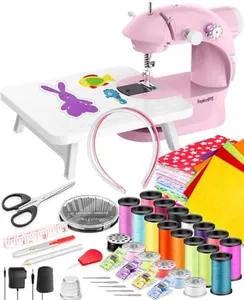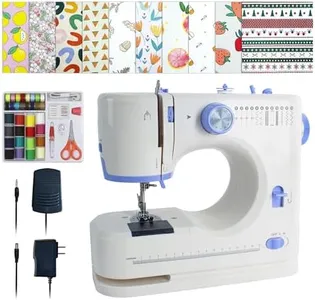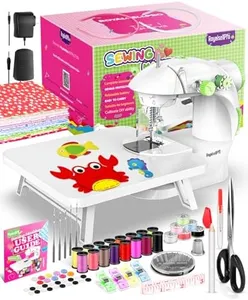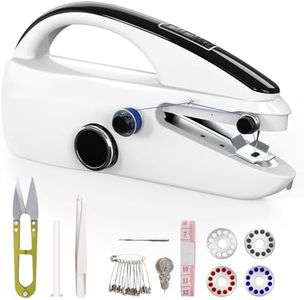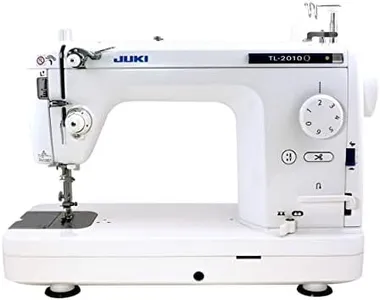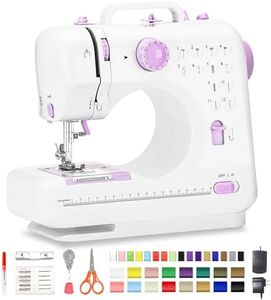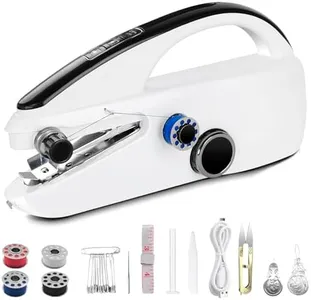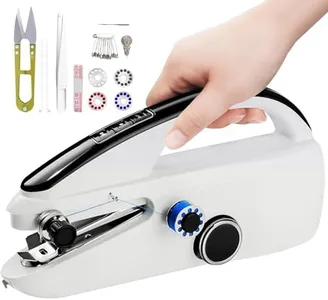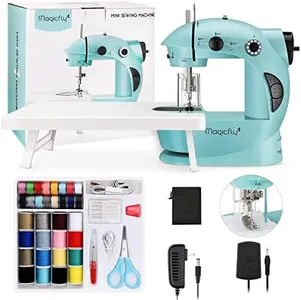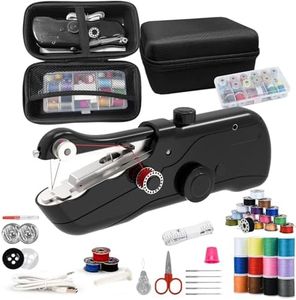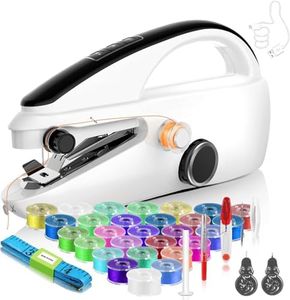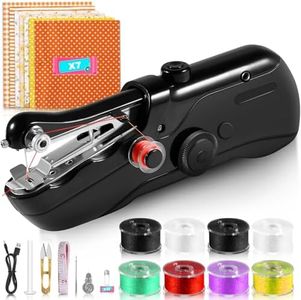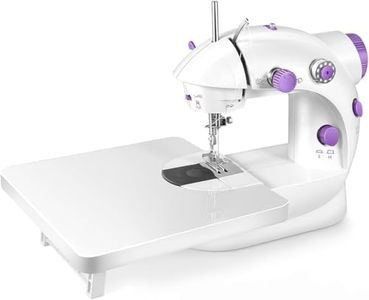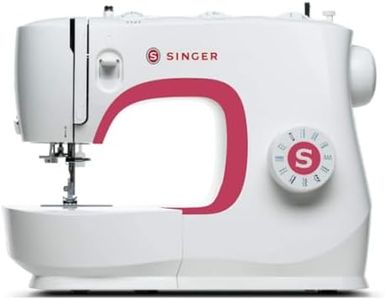10 Best Mini Sewing Machines 2025 in the United States
Our technology thoroughly searches through the online shopping world, reviewing hundreds of sites. We then process and analyze this information, updating in real-time to bring you the latest top-rated products. This way, you always get the best and most current options available.

Our Top Picks
Winner
Stoigeld Sewing Machine for Beginners with 20 Pcs Fabric and 32 Pcs Sewing Threads Kit,Portable Sewing Machine with 12 Built-in Stitches,2 Speed(High-Low Speeds) - White Blue
Most important from
99 reviews
The Stoigeld Sewing Machine is a compact, beginner-friendly option that stands out with its portability and comprehensive sewing kit. Weighing only 4.2 pounds and measuring 10.3 x 9.5 x 4.4 inches, it's easy to store and move, making it ideal for small spaces or taking on the go. The 12 built-in stitch options, including straight, zigzag, and decorative stitches, offer versatility for various sewing projects. It also features a reverse sewing function for added stitch durability.
The machine operates with an AC adapter, ensuring consistent power for longer sewing sessions without battery concerns. With two speed settings (High and Low), users can choose a comfortable pace for their sewing tasks. However, one notable drawback is the absence of a built-in light, which could make it challenging to sew in dim lighting.
On the plus side, the user-friendly design, complete with threading indication marks and a detailed manual, simplifies operation, making it accessible for beginners. Additionally, the included fabric and thread kit is a great starter set, and it makes for a thoughtful gift for new sewers or children. While reviews are highly positive, emphasizing ease of use and functionality, it's important to consider the lack of a built-in light if you often sew in low-light conditions.
Most important from
99 reviews
Royalsellpro Mini Sewing Machine with 123 Pcs Sewing Kit for Beginners, Dual Speed Portable Sewing Machine with Light and Finger Guard Suitable for Household, Travel
Most important from
289 reviews
The Royalsellpro Mini Sewing Machine is a compact and versatile option tailored for beginners and casual users. One of its standout features is the extensive 123-piece sewing kit that comes included, which provides a variety of essential tools such as needles, thread spools, and DIY accessories. This makes it particularly appealing for those just starting out, as they can jump right into various sewing projects like clothes, aprons, and even dolls. The complimentary eBook with sewing tutorials is another great asset, offering structured guidance across three difficulty levels, which can greatly enhance the learning experience.
In terms of usability, the mini sewing machine offers dual-speed options, allowing users to adjust the pace for different projects. The addition of a built-in light is particularly useful for sewing in dim conditions, making it more convenient for nighttime crafting. Safety is addressed with features like a finger guard, which adds an extra layer of protection as users learn.
Its lightweight and portable design, weighing just 3.74 pounds, coupled with the flexibility of being able to run on batteries or plug-in power, makes this machine ideal for both home use and travel. The Royalsellpro Mini Sewing Machine is a great choice for beginners or those looking for a convenient sewing machine for small projects. It strikes a good balance between ease of use, safety, and included accessories.
Most important from
289 reviews
Handheld sewing machine, portable, mini sewing machine, easy to use, fast sewing speed, suitable for sewing clothes, fabric, DIY Home machine for beginners(Black)
Most important from
42 reviews
The Aovly Clotho Ⅲ handheld sewing machine offers a portable and compact sewing solution, making it ideal for beginners and those needing a quick and mobile option for fabric repairs and DIY projects. Its lightweight design (14.4 ounces) and small dimensions (8.86 x 4.72 x 2.54 inches) ensure easy handling and storage without taking up much space. The machine includes a colorful illustrated manual, simplifying the learning process for those unfamiliar with sewing machines.
Additionally, it provides two-speed options to enhance work efficiency, accommodating both slow and fast sewing needs. Despite not being electric, the machine features ease of use with simple threading and adjustable needle height, allowing users to switch threads effortlessly. It comes with various accessories like scissors, high-quality threads, a soft ruler, and fixing needles, making it a complete package for beginners.
A strong point is its ability to sew through thick fabrics such as denim, thanks to the rigid needle. However, the lack of built-in light may require a well-lit environment for best results, and the absence of electric power might limit its use to manual operation only, potentially making it less suitable for larger or more complex sewing projects. Despite these limitations, the Clotho Ⅲ handheld sewing machine is a good choice for those seeking a portable, straightforward, and efficient sewing tool for quick fixes and simple DIY tasks.
Most important from
42 reviews
Buying Guide for the Best Mini Sewing Machines
Choosing the right mini-sewing machine can be a game-changer for your sewing projects, especially if you are a beginner or need a portable option. Mini-sewing machines are compact, lightweight, and often more affordable than full-sized machines, making them ideal for small projects, quick repairs, or learning the basics of sewing. To make an informed decision, it's important to understand the key specifications and how they align with your needs.FAQ
Most Popular Categories Right Now
